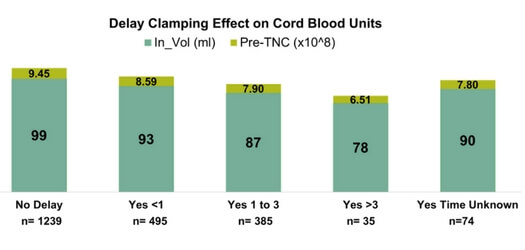You are here
Does Delayed Umbilical Cord Clamping Impact Family Banked Cord Blood?
 The practice of delayed umbilical cord clamping following a baby’s birth has been on the rise over recent years. Delayed cord clamping is when the medical professional allows the umbilical cord to pulse for some extended time, before clamping and cutting the cord. The delay allows a portion of the residual blood from the umbilical cord and placenta to enter the newborn’s circulation.
The practice of delayed umbilical cord clamping following a baby’s birth has been on the rise over recent years. Delayed cord clamping is when the medical professional allows the umbilical cord to pulse for some extended time, before clamping and cutting the cord. The delay allows a portion of the residual blood from the umbilical cord and placenta to enter the newborn’s circulation.
Families considering cord blood banking with a family bank, like ViaCord, may lack information regarding how often, how long, and the overall impact that delayed cord clamping can have on the usability of a family’s saved cord blood unit. Ultimately, if the decision to delay clamping is made, parents and medical professionals should work together to determine the amount of time. In order for parents to make a truly informed decision studies must be done to gain a better understanding of the effect delayed cord clamping has on cord blood saved for families.
That’s why we conducted a study to examine the effect delayed cord clamping can have on the volume and pre-processed total nucleated cell count based on the length of time clamping is delayed. The findings from our study, The Effect of Delayed Clamping on Umbilical Cord Blood Collection Volume and Total Nucleated Cell Count in the Family Banking Setting, were recently presented at the 15th International Cord Blood Symposium, and the abstract was published in the journal Transfusion.
For our study, data collection cards were provided to medical professionals who performed cord blood collections for ViaCord families. Over a four month period, more than 2,000 data collection cards were completed. On the cards medical professionals were asked to indicate if delayed clamping was performed, as well as the duration of the delay. The delays were categorized as: no delay, yes <1 minute, yes 1-3 minutes, yes > 3 minutes and yes time unknown.
Upon arrival at ViaCord’s processing lab, the cord blood collections were measured for initial cord blood volume and pre-processed TNC counts. The data collected over the four months was then averaged to evaluate the impact delayed clamping had on the cord blood collections. Below are our findings.
Family cord blood collection can be performed successfully even if cord clamping is delayed. However, given the importance of cell dose in transplant and regenerative medicine (for example, therapies for Autism & Cerebral Palsy), every effort should be made to collect as much cord blood as possible.
Parents planning to collect and bank their cord blood need to discuss and weigh the value of optimizing cord blood collection versus potential benefits of delayed cord clamping with their medical professional. For example, if a parent knows that the cord blood they’ll be collecting from their baby will be used in a sibling donor situation then delayed clamping should be avoided. Again, in all cases, blood collection should be optimized to get as much cord blood and as many cells as possible.
Further studies are needed to gain a deeper understanding of the impact that delayed cord clamping has on cord blood saved for family use and to evaluate optimal length of delay for those families choosing to both delay clamping and save the cord blood for their family.
Disclaimer: Banking cord blood does not guarantee that treatment will work and only a doctor can determine when it can be used. This is for informational purposes only; not intended for treatment or diagnostic purposes. Individuals should always consult with their healthcare providers.

 Figure caption: From our data we saw that longer delays in cord clamping reduced both the volume and pre-processed TNC (pre-TNC) count of cord blood units collected. Please note that all volumes include 35mL of anticoagulant.
Figure caption: From our data we saw that longer delays in cord clamping reduced both the volume and pre-processed TNC (pre-TNC) count of cord blood units collected. Please note that all volumes include 35mL of anticoagulant.